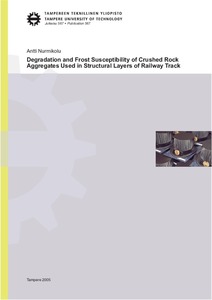Degradation and frost susceptibility of crushed rock aggregates used in structural layers of railway track
Nurmikolu, A. (2005)
Nurmikolu, A.
Tampere University of Technology
2005
Rakennustekniikan osasto - Department of Civil Engineering
This publication is copyrighted. You may download, display and print it for Your own personal use. Commercial use is prohibited.
Julkaisun pysyvä osoite on
https://urn.fi/URN:NBN:fi:tty-200810021033
https://urn.fi/URN:NBN:fi:tty-200810021033
Tiivistelmä
This study deals with the degradation of crushed rock aggregate in the structural layers of track as well as the factors influencing degradation and frost susceptibility of degraded aggregate. The research is based on literature review and laboratory analyses of degraded ballast samples from the ballast bed, new crushed rock aggregates and some natural coarse-grained soils.
In the experimental part of the research the degradation of ballast is assessed primarily by analysing samples from the ballast bed. Other examined properties besides grading are strength, water absorption and freeze-thaw resistance of coarse particles and water adsorption, specific surface area, pore size distribution, mineralogy and loss on ignition of fines. Based on observations the degradation of ballast in the Finnish railway network is largely due to mechanical breakage and abrasion of ballast grains from traffic loading and tamping. Chemical weathering of ballast samples proved generally insignificantly small, and where it occurred, it was limited to the surfaces of grains.
In the absence of long-term use experiences, the research strived to forecast especially the degradation of the frost protection and intermediate layer crushed rock aggregates in cyclic loading apparatus with three separate loading plates developed to simulate traffic load-ing. Despite the test technical limitations related to the test material interfaces, the factors affecting degradation could be observed and the magnitude of degradation under the loading conditions of the track structure assessed.
The frost susceptibility of aggregates was examined by the developed frost heave test arrangements. In certain crushed rock aggregate the frost susceptibility at under 15 % fines content was found to be directly proportional to the fines content of the material. As the result of a stepwise regression analysis performed to analyse various aggregates together a regression model based on the under 0.002 mm material content, water absorption of coarse particles and total pore volume of fines is presented. In this combined analysis of aggregates it was possible to explain frost susceptibility nearly as well as by fines content in the analysis of individual aggregates.
The practical results of the research include recommendations for the strength, mineralogy and grading of the crushed rock aggregate in the frost protection and intermediate layers of track structure.
KEYWORDS: crushed rock aggregate, track structure, degradation, fines, frost susceptibility, cyclic loading test, frost heave test, ballast, subballast, weathering, substructure, frost protection layer, coarse-grained material, pore size distribution, water absorption
In the experimental part of the research the degradation of ballast is assessed primarily by analysing samples from the ballast bed. Other examined properties besides grading are strength, water absorption and freeze-thaw resistance of coarse particles and water adsorption, specific surface area, pore size distribution, mineralogy and loss on ignition of fines. Based on observations the degradation of ballast in the Finnish railway network is largely due to mechanical breakage and abrasion of ballast grains from traffic loading and tamping. Chemical weathering of ballast samples proved generally insignificantly small, and where it occurred, it was limited to the surfaces of grains.
In the absence of long-term use experiences, the research strived to forecast especially the degradation of the frost protection and intermediate layer crushed rock aggregates in cyclic loading apparatus with three separate loading plates developed to simulate traffic load-ing. Despite the test technical limitations related to the test material interfaces, the factors affecting degradation could be observed and the magnitude of degradation under the loading conditions of the track structure assessed.
The frost susceptibility of aggregates was examined by the developed frost heave test arrangements. In certain crushed rock aggregate the frost susceptibility at under 15 % fines content was found to be directly proportional to the fines content of the material. As the result of a stepwise regression analysis performed to analyse various aggregates together a regression model based on the under 0.002 mm material content, water absorption of coarse particles and total pore volume of fines is presented. In this combined analysis of aggregates it was possible to explain frost susceptibility nearly as well as by fines content in the analysis of individual aggregates.
The practical results of the research include recommendations for the strength, mineralogy and grading of the crushed rock aggregate in the frost protection and intermediate layers of track structure.
KEYWORDS: crushed rock aggregate, track structure, degradation, fines, frost susceptibility, cyclic loading test, frost heave test, ballast, subballast, weathering, substructure, frost protection layer, coarse-grained material, pore size distribution, water absorption
Kokoelmat
- Väitöskirjat [4769]
